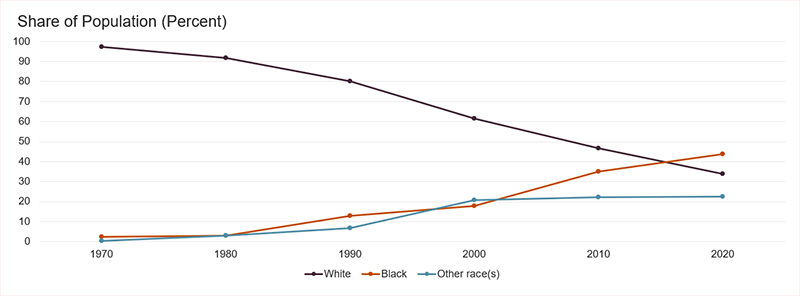Homebuying Trends in Metro Boston Contribute to New Locations of Racial Segregation
Residential racial segregation is not only on the rise, but is shifting locations: recent research found that 81 percent of all US metros over 200,000 residents were more segregated in 2019 than in 1990. As gentrification and housing unaffordability price lower-income residents out of major cities, we see new racial inequalities emerging on the metropolitan fringe. In our previous blog, we discussed how movements to incorporate new cities in the Atlanta area have perpetuated new patterns of racial segregation. In this second blog, we show how unequal housing choices shape new locations of segregation across metropolitan Boston.
Boston has a contentious history of racial residential segregation. Today’s high housing prices are also pricing Black families out of Boston, and the city’s Black population has leveled off even though the region’s Black population has increased. Many Black families have been moving to newly segregating, post-industrial cities on the metropolitan edge. One notable example is Brockton, a city of 100,000 that has seen profound racial change since 1980 and became the first Black-majority city in New England (Figure 1). Many of its newcomers are Black immigrants from Cabo Verde and Haiti.
Figure 1: The City of Brockton Changed from White-Majority to Black-Majority Since 1970
Sharon has studied Brockton since 2019 and found that the city is becoming increasingly segregated from its surrounding communities, not because white long-time residents are leaving (also called “white flight”), but because few new white homebuyers are moving to Brockton. For instance, when she visited 15 open houses for Brockton starter homes last summer, she observed that over 80 percent of viewers were Black families, including many immigrant and multigenerational households. These observations are consistent with Home Mortgage Disclosure Act (HMDA) data on home sales. Figure 2 highlights how a growing proportion of homebuyers in Brockton are Black, with 64 percent identifying as Black in 2021. But from 2018 to 2021, the proportion of white homebuyers in Brockton dropped from 23 to 16 percent, indicating that white buyers became less likely to buy in Brockton during this period. By contrast, homebuyers in Plymouth County (where Brockton is located) remain predominantly white.
Figure 2: Few White Homebuyers Buy in Brockton, a Trend That Has Intensified
| 2018 | 2019 | 2020 | 2021 | |
|---|---|---|---|---|
| Brockton | ||||
| Black | 55% | 57% | 58% | 64% |
| White | 23% | 22% | 21% | 16% |
| Plymouth County (except Brockton) | ||||
| Black | 2% | 2% | 3% | 4% |
| White | 93% | 92% | 91% | 88% |
The emerging racial segregation of Brockton from surrounding communities is not unique. Indeed, Figure 3 shows how most Black homebuyers purchase only in a small number of census tracts across eastern and central Massachusetts, with southern Boston neighborhoods, the city of Brockton, Taunton, and the town of Randolph standing out. At the same time, in 508 out of 1,453 tracts with available data, 1 percent or less of all homebuyers were Black: representing over one third of all Massachusetts tracts. These homebuying patterns are contributing to new patterns of segregation emerging between communities across the Commonwealth.
Figure 3: Most Black Homebuyers Are Concentrated in a Small Number of Massachusetts Tracts
Policymakers Have Resources to Redress Racial Disparities
In 2020 Boston was ranked the 11th most segregated metro between Black and white residents in the United States top 50 metro areas. Residential segregation has resulted in stark racial disparities in education, health, and opportunities. Policymakers have many tools at their disposal, however, to address these issues.
State governments can legally impose requirements and limitations through preemption laws to promote affordable housing. For example, Chapter 40B in Massachusetts helps developers override local zoning regulations in communities where less than 10 percent of housing is defined as affordable, if 20 to 25 percent of units in their developments include long-term affordability restrictions. States can also ban single-family zoning as was done in Oregon or require up-zoning in areas served by public transit. Indeed, single-family zoning and minimum lot requirements have been associated with racial and socio-economic exclusion.
In addition, states and local governments can take measures to tackle contemporary housing discrimination and ensure that all communities are welcoming to new residents, regardless of racial identity or national origin. The federal government recently renewed its commitment to fostering inclusive communities through the proposed Affirmatively Furthering Fair Housing rule. At a local level, such a commitment may include stronger monitoring of Fair Housing Act violations, such as through “paired testing” studies on discrimination in home lending, home appraising, and homebuying. Strengthened enforcement of the Fair Housing Act could mitigate segregation shaped by discrimination.



